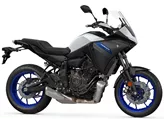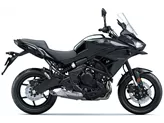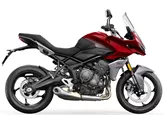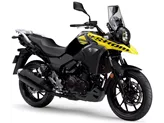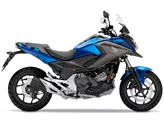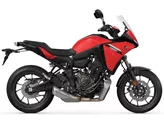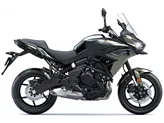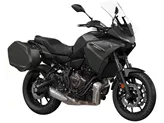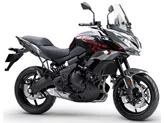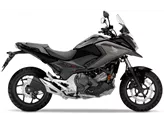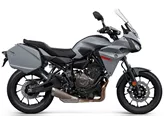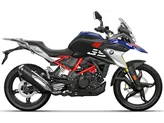Kawasaki Versys 650 2016 vs. Kawasaki Versys-X 300 2017

Kawasaki Versys 650 2016

Kawasaki Versys-X 300 2017
Overview - Kawasaki Versys 650 2016 vs Kawasaki Versys-X 300 2017
The Kawasaki Versys 650 2016 and the Kawasaki Versys-X 300 2017 are both enduro motorcycles from Kawasaki, but they have several differences in terms of their technical specifications and strengths.
In terms of engine specifications, the Kawasaki Versys 650 2016 has an inline engine with a bore of 83 mm and a stroke of 60 mm. It delivers a powerful engine power of 69 HP and a torque of 64 Nm. On the other hand, the Kawasaki Versys-X 300 2017 also has an inline engine but with a smaller bore of 62 mm and stroke of 49 mm. It has a lower engine power of 39 HP and a torque of 27 Nm.
Both motorcycles have electric starters and chain transmissions, but the Kawasaki Versys 650 2016 has a larger displacement of 649 ccm compared to the 296 ccm of the Kawasaki Versys-X 300 2017. This means that the Versys 650 has a more powerful engine overall.

Kawasaki Versys 650 2016
In terms of suspension, the Kawasaki Versys 650 2016 has an upside-down telescopic fork front suspension, while the Versys-X 300 2017 has a telescopic fork front suspension. Both motorcycles have steel frames and front disc brakes, but the Versys 650 has double disc brakes while the Versys-X 300 has a single disc brake.
The dimensions and weights of the motorcycles also differ. The Kawasaki Versys 650 2016 has a front tire diameter of 17 inches and a rear tire width of 160 mm, while the Versys-X 300 2017 has a larger front tire diameter of 19 inches and a smaller rear tire width of 130 mm. Both motorcycles have a rear tire diameter of 17 inches. Additionally, the Versys 650 has a larger fuel tank capacity of 21 liters compared to the 17 liters of the Versys-X 300.

Kawasaki Versys-X 300 2017
In terms of strengths, the Kawasaki Versys 650 2016 has adjustable brake and clutch levers, a wide range of use, a sporty look, and a larger fuel tank capacity which makes it suitable for longer rides. On the other hand, the Kawasaki Versys-X 300 2017 has a high-revving engine, low weight, a large steering angle, an assist and slipper clutch, and is considered a good basis for a touring machine.
However, both motorcycles also have weaknesses. The Kawasaki Versys 650 2016 has narrow handlebars, which may not be comfortable for some riders, and it can feel somewhat sluggish in bends. It also has a high seat, which may be a disadvantage for shorter riders. On the other hand, the Kawasaki Versys-X 300 2017 has a hard bench, which may not provide optimal comfort for long rides.
In conclusion, the Kawasaki Versys 650 2016 and the Kawasaki Versys-X 300 2017 have different engine specifications, suspension, dimensions, and strengths. The Versys 650 has a more powerful engine and larger fuel tank capacity, while the Versys-X 300 is lighter and has features that make it suitable for touring. Both motorcycles have their own strengths and weaknesses, and the choice between them would depend on the rider's preferences and intended use.
Technical Specifications Kawasaki Versys 650 2016 compared to Kawasaki Versys-X 300 2017
Pros and Cons in comparison
Pros and Cons in comparison
Kawasaki Versys 650 2016

When it was first introduced, the Versys 650 was a refreshing, modern concept that combined lots of fun with a lively in-line two-cylinder engine, high everyday utility and a wide range of uses. In the meantime, it has a few years under its belt and, after the visual update, which is very successful, it also deserves a technical overhaul. While the tank should not shrink, a lower seat height would be desirable.
Kawasaki Versys-X 300 2017

Solid, simple, good. The Kawasaki Versys-X 300 is certainly not the most exciting model in the green product range. But it is a successful addition to the Versys family and will appeal to many beginners. The handling is easy and brings a lot of fun on asphalt and gravel. Whether you ride it at 12,000 rpm and drag footpegs or explore the countryside over dirt roads, the Versys-X 300 proves to be a very versatile motorbike. With accessories, it can also be quickly transformed into a touring machine that promises long-term qualities with simple technology.
Price Comparison Avarage Market Price Kawasaki Versys 650 vs Kawasaki Versys-X 300
There are a few key differences between a Kawasaki Versys 650 2016 and a Kawasaki Versys-X 300 2017. In terms of price, the actual average price of a Kawasaki Versys 650 2016 is about 49% higher. Compared to Kawasaki Versys-X 300 2017 there are more Kawasaki Versys 650 2016 bikes available on the 1000PS.de Marketplace, specifically 10 compared to 6. It takes less time to sell a Kawasaki Versys 650 with 101 days compared to 160 days for a Kawasaki Versys-X 300. Since model year 2007 1000PS.de editors have written 39 reviews for the Kawasaki Versys 650 and 5 reviews for the Kawasaki Versys-X 300 since model year 2017. The first review for the Kawasaki Versys 650 was published on 7/25/2006 and now has more than 3,900 views. This compares to more than 34,100 views for the first review on Kawasaki Versys-X 300 published on 11/8/2016.



